Volvo Connection and Parameter Setting
TD/TAD420VE, TD/TAD520GE, TAD520VE, TAD530GE, TAD531GE, TAD532GE, TAD620VE, TD720GE, TAD720GE, TAD720VE, TAD721GE/VE, TAD722GE/VE, TAD730/731/732/733GE
Control unit
The control unit must be installed separately from the engine. Control unit working temperature must be between - 40 °C to +85 °C.
Accelerator pedal (VE engines)
Idling: 0-5 V (standard value 0.3 V)
Full throttle: 0-5 V (default value 4.6 V)
A fault code is generated when the voltage is:
U > 4.9 V (standard value)
U < 0.1 V (standard value)
Engine speed potentiometer/external voltage input (GE engines)
Rotary potentiometer for fine adjustment of engine speed (GE engines)
On 1500 rpm or 1800 rpm GE engines, the Volvo engine speed can be finely adjusted ±5 %. A fault code is generated when the voltage is:
U > 4.8 V (standard value)
U < 0.2 V (standard value)
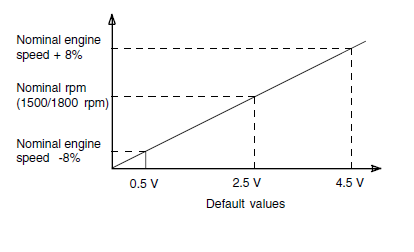
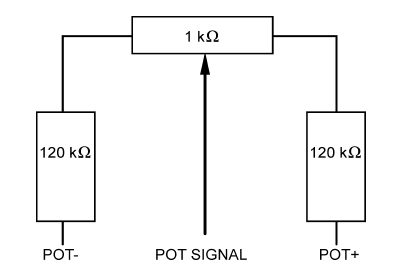
This accelerator pedal/potentiometer corresponds to the control unit standard value (0.5 V or 4.5 V respectively).
The end position resistor is used to detect electrical faults in the accelerator/potentiometer (end position resistors are built into many accelerators/potentiometers and do not need to be added in these cases).
1500/1800 rpm switch
This function makes it possible to switch engine speed between 1500 and 1800 rpm. Switch type, two-position (NO).
Droop switch
The switch must be closed to obtain droop. Switch type, two-position (NO).
Alarm, low oil pressure
Max. power 3 W
Voltage 12 V/24 V
Alarm, high coolant temperature
Max. power 3 W
Voltage 12 V/24 V
Tachometer
Tachometer used, graduated 0-2600 rpm and with adjustable input frequency.
44 pulses/r (420/620 engines)
48 pulses/r (520/720 engines)
Diagnostic lamp
Max. power 3 W
Voltage 24 V
Diagnostic button
Switch type, closing (NO), spring biased.
To read the fault codes, please refer to the “Fault finding” chapter.
VODIA input
Deutsch 6-pin connector
To read the fault codes, please refer to the “Fault finding” chapter.
Adjustable parameters
The VODIA tool (including Penta EDC 4 software) can be used to read and adjust the parameters below, in “Parameter Programming” mode. For instructions, see “VODIA User´s Guide”.
NOTE! Special authorization is needed to be able to adjust certain parameters.
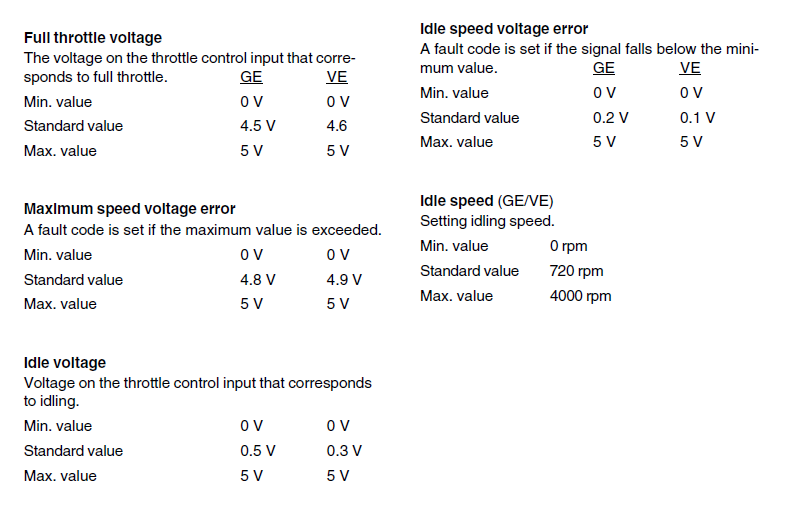
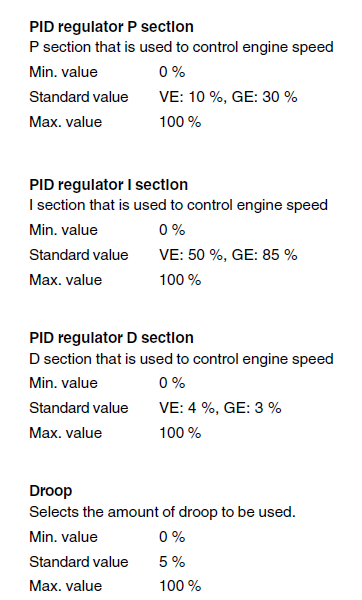

Coolant temperature protection (Special authorization needed)
Chooses whether engine protection should be activated in relation to high coolant temperature.
Alternative positions “Off” or “On”
Default value: “On”
If “On”, the coolant temperature warning lamp lights up at 110 °C (goes out at 109°C)
The engine is shut off at 113 °C after 30 sec.
Coolant level protection (Special authorization needed)
Chooses whether engine protection should be activated in relation to low coolant level.
Alternative positions “Off” or “On”
Default value: “On”
If “On”, the control unit does not check this function until 25 s after starting. When the control unit receives a low coolant level signal, the engine is shut off after 5 sec.
Oil pressure protection (Special authorization needed) Chooses whether engine protection should be activated in relation to low oil pressure.
Alternative positions “Off” or “On”
Default value: “On”
If “On”, the control unit does not check this function until 30 s after starting.
The limit values depend on engine speed. The oil pressure warning lamp lights up when the limit value is reached, and goes out again when the oil pressure has risen 10 % above the limit value. The engine is shut off when oil pressure falls to 80 % of the limit value. Examples of default values: 800 rpm – the oil pressure warning lamp lights up at 0.9 bar (goes out at 1 bar) and the engine is shut off at 0.72 bar.
2000 rpm – the oil pressure warning lamp lights up at 2.5 bar (goes out at 2.75 bar) and the engine is shut off at 2 bar.
Read-only parameters
The VODIA tool (including Penta EDC 4 software) can be used to read the values below in “Log test” mode.
For instructions, see “VODIA User´s Guide”.
• Battery voltage
• Coolant temperature
• Charge air pressure
• Oil pressure
• Fuel temperature
• Engine speed
• Throttle control %
• Droop %
• Throttle control voltage (Only in “Parameter, programming”
position on VODIA tool)
• Engine total running time
• Engine load %
Fine adjustment, engine speed regulator
Use the VODIA tool (including Penta EDC 4 software), to read and adjust the P, I and D sections of the engine speed regulator. In some cases, this can offer more stable and more even engine running.
PID = Proportional, Integrating, Differential
The P section amplifies (Gain). A reduced value (Fig. 1) gives slower regulator reaction with change of load. An increased value (Fig. 2) gives a faster reaction. The I section stabilizes (Stability). A reduced value (Fig. 3) increases the time for system recovery with change of load. An increased value (Fig 4) gives a shorter recovery time.
The D section stabilizes (Differential). Reacts to the magnitude of the engine speed change. A reduced value (Fig 4) gives reduced sensitivity. An increased value (Fig. 5) gives increased sensitivity. Before any adjustments are made, the current values of the P, I and D sections of the PID regulator should be noted.
NOTE! Without the default values, the engine speed regulator/actuator can not be restored if adjustment is not successful.
For instructions, see “VODIA User´s Guide”.
Adjustment
1. Use the VODIA tool and note the current values of the P, I and D sections of the PID regulator
2. Start the engine.
3. Run the engine at working speed without load, and first increase the value of the P section of the PID regulator until unstable (oscillating) engine speed is achieved. Then reduce the parameter by 1-2 % until the engine speed is stable again.
4. Then adjust the I section of the PID regulator in the same way as above.
5. If the engine still runs badly and no other adjustments help, increase the D section of the PID regulator until the engine only has a very small increase in speed when load is applied or removed, please refer to fig. 6.
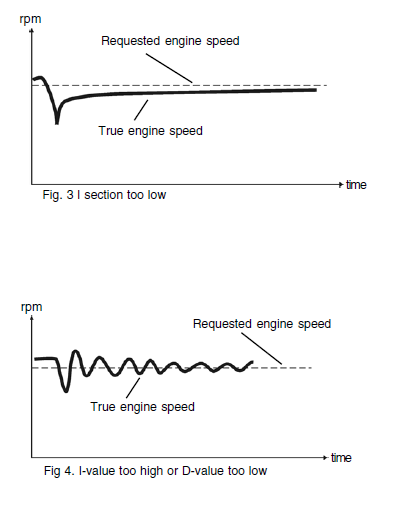
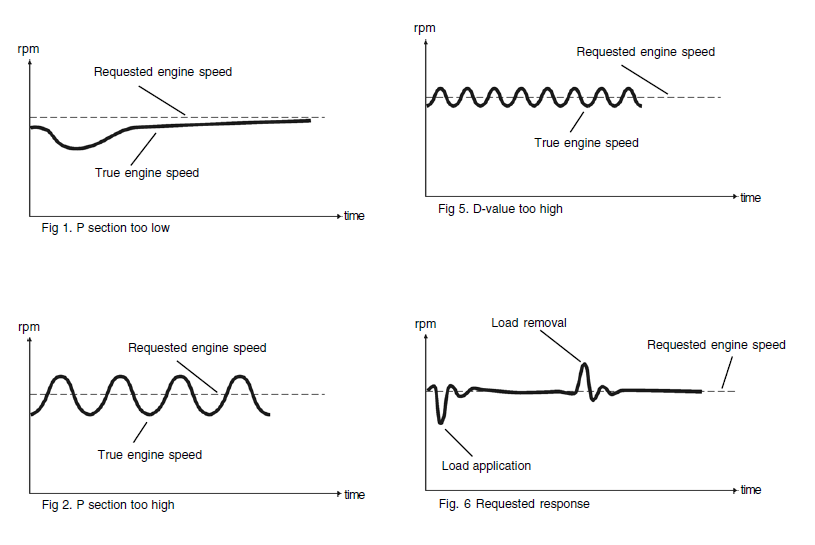
NOTE! The few times that the D section may need to be adjusted include cases where the application has a flexible coupling or extremely low flywheel inertia.
6. Adjust the P and I sections again as above, if necessary.
7. Check the engine response according to fig. 6.
For More Volvo Engine workshop information, please visit:
Volvo Engine TAD1341/42/43/44/45GE Technical Data
Volvo Engine Electrical System Maintenance
Copyright © Guangxi Dingbo Generator Set Manufacturing Co., Ltd. All Rights Reserved | Sitemap
Update cookies preferences